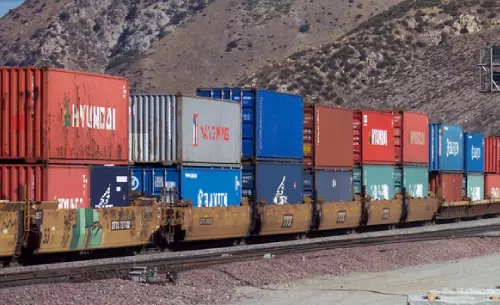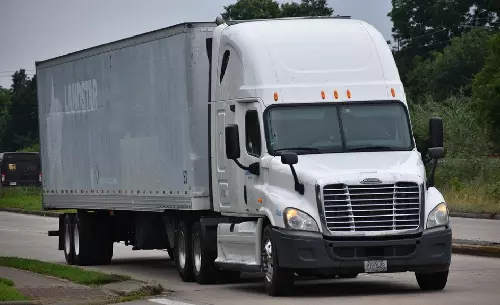Two of the most popular land freight modes that are often compared and considered are rail transport and trucking. They are usually the most frequently used modes of transport due to their affordability, convenience and reliability.
The difference between moving cargo via rail or truck is that rail freight is typically three to four times more affordable and fuel efficient. On the other hand, trucking allows for better access to delivery locations and facilitates cargo transport based on individual scheduling.
There are various other similarities and differences between both modes of transport that we will explore in this article. But first, let’s take a closer look at how rail freight and trucking are defined before analyzing the similarities and differences.
What is Rail Freight?
Rail freight is the transportation of goods via the rail network. In this mode of transport, cargo is moved across rail networks on freight trains that carry single and double-stacked containers in multiple well cars.

Transporting cargo via the rail network is an efficient way of moving cargo between long distances because it can carry an average of 300 shipping containers in a single trip and is able to cover vast distances.
Coming into prominence in the early 1800s, rail networks expanded rapidly and rail freight became a popular mode of inland transport. In today’s logistics environment, trains carry a large number of containers between inland depots, ports and freight stations.
Containers are loaded onto trains using specialized container handling equipment such as reach stackers and gantry cranes. While containerized cargo transport remains one of the most common rail freight methods, they are also a popular means of transporting bulk and out of gauge (OOG) cargo.
Freight trains are also able to be equipped with various types of cars or wagons to facilitate modes such as trailer on flatcar or container on flatcar arrangements.
What is Trucking?
Trucking is a mode of transport in which goods are moved from one location to another using a truck. These trucks can cover vast distances using the road network and come in various sizes, depending on the cargo they are transporting.

One of the most common trucks that are particularly popular for last mile deliveries are vans. These are commonly used for smaller consignments, such as e-commerce purchases and parcel deliveries.
Other common trucks are 4, 6 ot 10-wheelers, flatbed trucks for out of gauge cargo or container trucks, which transport containers between different locations. Trucking remains one of the fastest ways to deliver cargo and is the main mode of transport when it comes to container movements.
Similarities and Differences Between Rail and Truck Transport
Both rail freight and trucking have their advantages when it comes to moving cargo from one location to another. In the following section, we’ll be comparing both modes of transport and will also be taking a closer look at costs, flexibility, reliability, capacity, range, coverage and emissions.
Cost
One of the main differences between rail freight and trucking is the cost to move cargo. On the one hand, there are direct transportations costs and on the other hand there are also external costs. Let’s take a closer look.
The publication Pricing Freight Transport to Account for External Costs by the Congressional Budget Office released in 2015 found that moving cargo via rail costs about 5.1 cents per ton-mile, compared to 15.6 cents per ton-mile when using trucks.
This makes rail freight about 3 – 4 times more affordable, due to the capacity that freight trains can handle. This concept is rather easy to understand, as a truck can handle 1 – 2 containers per trip, whereas a train can handle a few hundred.
There are also external costs that indicate that rail freight is more cost-effective than trucking. The same study referenced above showed that external costs per ton-mile amounted to about $2.62 – $5.86 for road transport compared to only $0.3 – $0.82 for rail transport.
These external costs include but are not limited to pavement and rail repairs, traffic congestions, accident risk, traffic congestions and emissions.
Flexibility
In terms of flexibility, trains and trucks have several differences. On the one hand, freight trains usually depart based on a schedule, as they travel between freight stations or between inland depots and ports. As train schedules are carefully planned by operators, trains commonly depart on time.
On the other hand, trucks are usually dispatched according to delivery requests. These deliveries are typically planned by the trucking operator, shipper or consignee, as and when deliveries are required.
Therefore, moving cargo via trucks allows for a more customized schedule as needed, whereby trains usually depart based on a preplanned schedule.
Reliability
Freight trains are designed to move a large number of shipping containers and cargo over long distances via a rail network. As there are very few intersections and train stations in between routes, trains rarely get affected by traffic, weather, repairs and other forms of congestion.
However, the same cannot be said about trucks. While trucks are able to depart according to flexible schedules, goods are transported via the road network. This means that they are subject to congestion and traffic which can heavily delay deliveries.
Capacity
There is also a major difference between freight trucks and freight trains with regards to capacity. In the United States for example trucks are able to have a maximum gross weight of 80,000 lbs (about 36,300 kg). Therefore, trucks typically move cargo that weighs between 20,000 to 60,000 per trip.
On the other hand, trains have a much larger capacity. It’s not uncommon to see freight trains that have between 100 – 150 train cars, which can carry about 200 – 300 containers in total, depending if they are double or single stacked.
Assuming that the average gross container weighs about 33,000 lbs (about 15,000 kg), this means that a freight train can move close to 10,000,000 lbs in a single trip.
Range
The range of freight trains is unmatched. Rail networks span across thousands of miles and through rail electrification don’t require any form of stops throughout the entire journey.
Moreover, train drivers or enginemen are able to operate trains for longer periods of time, as there is extremely limited traffic and zones where special attention is required.
This is different for trucks. Under the Hours of Service Regulations, truck drivers in the US are not allowed to be on duty for more than 14 hours. Of those 14 hours, they are not allowed to drive for more than 11 hours.
In the European Union for example, truck drivers are only allowed to operate their truck up to 9 hours per day and a total of 56 hours per week. Over a two-week period, they are only allowed to clock in a total of 90-hours, meaning that multiple rests stops are required.
Therefore, trains have a much longer range and are therefore also used to cover longer distances, whereby trucks are used for mid-range and short-range cargo transport.
Coverage
The main advantage of trucks compared to trains is that they have a much wider and accurate coverage. While freight trains can only operate on rail networks and facilitate transport between freight stations, port and inland depots, trucks are able to access any type of commercial or residential area through a vast road network.
This also means that even though cargo is transported by freight trains, containers, bulk cargo and other goods need to be eventually loaded onto trucks for the final delivery.
Emissions
Based on the U.S.Transportation Sector Greenhouse Gas Emissions publication of the US Environmental Protection Agency (EPA) from 2021, the transportation sector contributes about 29% of total emissions.
Moreover, medium and trucks accounted for about 24% of the 29%, with rail transport only 2%. Of course, you should take into account that there are more trucks than trains in operation.
There are a few reasons why freight trains are more environmentally friendly than trucks. This is mainly due to the fact that the rail network is electrified and that by design, freight trains are able to transport hundreds of containers in a single trip.
This means that the emissions per ton-mile for trains are significantly lower than any other mode of land transport. On average trains are about 3 – 4 times more fuel efficient than trucks.

Get Free Course Access
If you enjoyed the article, don’t miss out on our free supply chain courses that help you stay ahead in your industry.

Andrew Lin
Co-Founder & Writer
at freightcourse
About the Author
Andrew is a multi-business owner with over 12 years of experience in the fields of logistics, trucking, manufacturing, operations, training, and education.
Being the co-founder of freightcourse has given him the ability to pursue his desire to educate others on manufacturing and supply chain topics.
Follow us